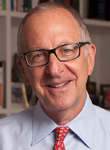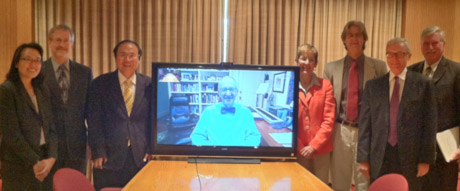Skorton chairs California meetings from Ithaca
By Teresa Craighead

How do ultra-busy chief executives like President David Skorton manage to “be” everywhere they need to be, and what lessons in efficiency and collaboration can we learn from how they leverage technology to meet demands?
As part of his participation in a Western Association of Schools and Colleges (WASC) accreditation committee review of the University of California, Santa Barbara, Skorton chaired one visit on-site in 2011. His second visit was scheduled for 2013 and involved leading 14 meetings over three days. Skorton opted to chair the meetings remotely from Ithaca – a decision endorsed by the accrediting agency and UC Santa Barbara as a “futuristic” way to chair the meetings.
Skorton turned to David Kuo, CIT executive support technical consultant, to discuss using Skype. Kuo agreed it was possible but identified several concerns and worked with his counterparts in Santa Barbara to address them: With Skorton functioning as a “virtual chair” and as the only remote participant, what could be done to ensure the meetings were productive? How could they ensure the audio and video quality would be sufficient? How could they accommodate meetings – some back-to-back, many located in different rooms – with shifting groups of people?
“They ended up with a laptop projected onto a TV, which was placed on conference room tables,” said Kuo. Real-time Skype video of Skorton appeared on the TV. When it was time for the next meeting, they moved the laptop and AV equipment to the next room. “Santa Barbara had to set up audio too,” said Kuo,” because a laptop microphone is not sufficient for multiple people.”

A similar setup was used for two open forums for UC Santa Barbara staff and faculty that were part of the accreditation process.
Of 14 meetings, the approach failed in only one team meeting in a hotel with a bad Internet connection. In that instance the participants used a telephone conference call.
Why Skype? While other Web conferencing and video conferencing capabilities available at Cornell and UC Santa Barbara offer useful collaboration capabilities and the ability to set up multipoint conferences, Skype was chosen because the quickly moving agenda and because Skorton could manage the technology himself.
Said Richard Osborn, vice president of WASC Senior College and University Commission, the accrediting agency for California institutions: “It went splendidly well … The key was President Skorton’s ability to create a natural and warm atmosphere to the point that the team and university hardly noticed the technology.”
“I took my responsibilities as chair of the accreditation committee very seriously, but my schedule this semester was such that I simply could not commit two full days for travel to and from the West Coast to chair the meetings in person,” Skorton said. “Skype offered a way to fulfill my responsibilities to the WASC commission and to UCSB while dealing with pressing issues here at Cornell.
“Because of the time difference between New York and California, the accreditation meetings extended beyond the typical workday in Ithaca, making the ability to connect remotely from different locations without in-person IT support especially important. My CIT colleagues and their counterparts at UCSB expertly set up Skype on three different computer systems. I knew we were breaking new ground with our ‘virtual’ meetings, but we accomplished our goals and also enjoyed a sense of being technology pioneers.”
The lesson in this experience, said Kuo, is “If a relatively simply application such as Skype can be used for something like this, we can all consider doing a lot more of it and maybe think twice about traveling.”
Teresa Craighead is a writer for Cornell Information Technologies.
Media Contact
Get Cornell news delivered right to your inbox.
Subscribe